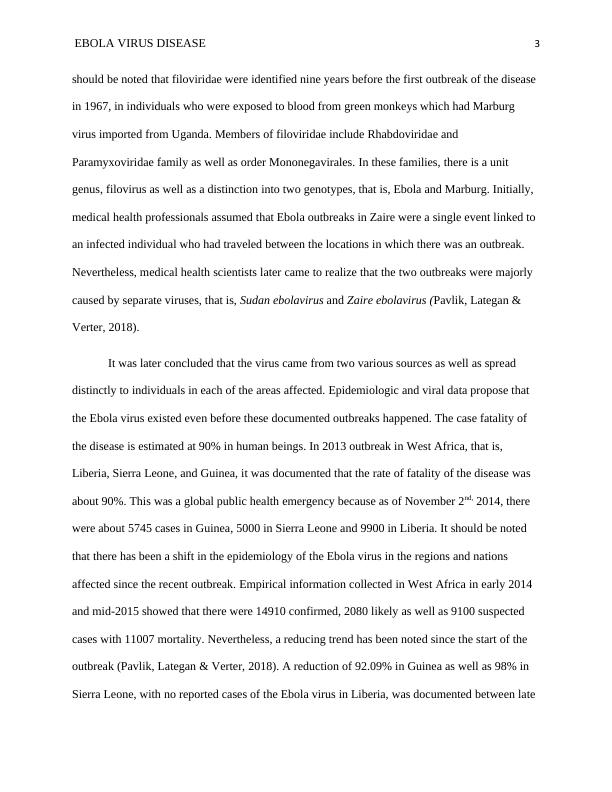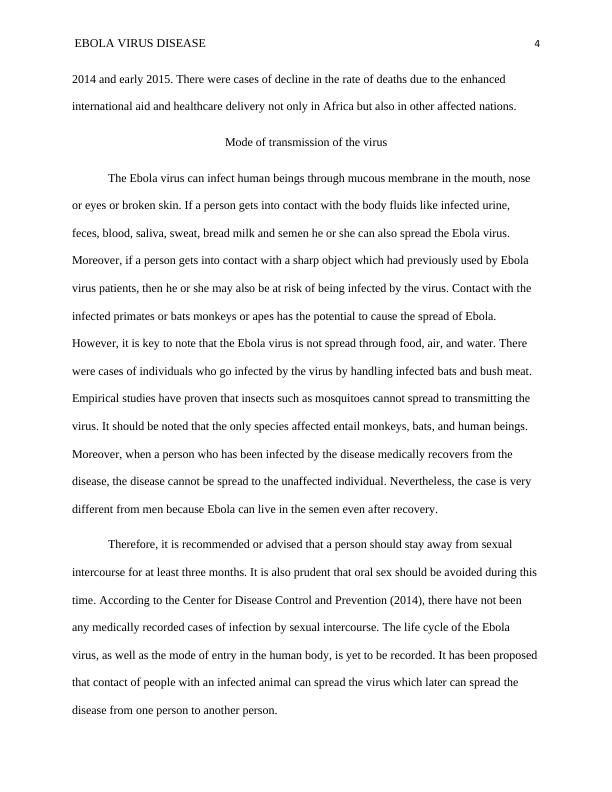Ebola Virus Disease: Prevalence, Treatment, and Challenges
Added on 2023-01-17
11 Pages3352 Words26 Views
Running Head: EBOLA VIRUS DISEASE
Ebola Virus Disease
Students Name
University Affiliation
Date
Ebola Virus Disease
Students Name
University Affiliation
Date

EBOLA VIRUS DISEASE 2
Ebola Virus Disease
Introduction
Global health has come out in the past twenty years as an academic discipline, a
collection of problems and as a discourse which has not yet established clear aims, principles,
and boundaries. Global health unevenly integrates the concerns and logic of biosecurity and
humanitarianism as well as is also inherently linked to the responsibilities and roles of nations,
their obligations to effectively safeguard people’s health and their capacity and willingness to do
so. These sides of global health inherently interconnected and overlapping, via various actors
within international health may recognize themselves more or less with each of them. Ebola is a
global health concern which requires biosecurity and humanitarianism policies (Hodge, Barraza,
Measer & Agrawal, 2014). Understanding the disease needs consideration of institutional, social,
political structures across numerous scales. However, it starts with the machinations and
vulnerabilities of the body are of key concerns regarding the disease; the body infected by the
virus is shown as an objected of disgust, mystery, care, compassion, and pity. The most
significant descriptions of the disease in the news, as well as other public fields, amplified the
components of fear and disgust which are entailed in the traditional representations of Ebola.
This paper will discuss the prevalence of Ebola Virus Disease, treatment, prevention, perceptions
and challenges faced by healthcare professionals in handling the disease.
Epidemiology of the disease
Ebola was named after river valley in the modern-day Democratic Republic of Congo,
formerly Zaire, where it was first identified, and started its publicity in the limelight of an
epidemic. Ebola is one of the members of viruses in RNA known as Filoviridae. However, it
Ebola Virus Disease
Introduction
Global health has come out in the past twenty years as an academic discipline, a
collection of problems and as a discourse which has not yet established clear aims, principles,
and boundaries. Global health unevenly integrates the concerns and logic of biosecurity and
humanitarianism as well as is also inherently linked to the responsibilities and roles of nations,
their obligations to effectively safeguard people’s health and their capacity and willingness to do
so. These sides of global health inherently interconnected and overlapping, via various actors
within international health may recognize themselves more or less with each of them. Ebola is a
global health concern which requires biosecurity and humanitarianism policies (Hodge, Barraza,
Measer & Agrawal, 2014). Understanding the disease needs consideration of institutional, social,
political structures across numerous scales. However, it starts with the machinations and
vulnerabilities of the body are of key concerns regarding the disease; the body infected by the
virus is shown as an objected of disgust, mystery, care, compassion, and pity. The most
significant descriptions of the disease in the news, as well as other public fields, amplified the
components of fear and disgust which are entailed in the traditional representations of Ebola.
This paper will discuss the prevalence of Ebola Virus Disease, treatment, prevention, perceptions
and challenges faced by healthcare professionals in handling the disease.
Epidemiology of the disease
Ebola was named after river valley in the modern-day Democratic Republic of Congo,
formerly Zaire, where it was first identified, and started its publicity in the limelight of an
epidemic. Ebola is one of the members of viruses in RNA known as Filoviridae. However, it

EBOLA VIRUS DISEASE 3
should be noted that filoviridae were identified nine years before the first outbreak of the disease
in 1967, in individuals who were exposed to blood from green monkeys which had Marburg
virus imported from Uganda. Members of filoviridae include Rhabdoviridae and
Paramyxoviridae family as well as order Mononegavirales. In these families, there is a unit
genus, filovirus as well as a distinction into two genotypes, that is, Ebola and Marburg. Initially,
medical health professionals assumed that Ebola outbreaks in Zaire were a single event linked to
an infected individual who had traveled between the locations in which there was an outbreak.
Nevertheless, medical health scientists later came to realize that the two outbreaks were majorly
caused by separate viruses, that is, Sudan ebolavirus and Zaire ebolavirus (Pavlik, Lategan &
Verter, 2018).
It was later concluded that the virus came from two various sources as well as spread
distinctly to individuals in each of the areas affected. Epidemiologic and viral data propose that
the Ebola virus existed even before these documented outbreaks happened. The case fatality of
the disease is estimated at 90% in human beings. In 2013 outbreak in West Africa, that is,
Liberia, Sierra Leone, and Guinea, it was documented that the rate of fatality of the disease was
about 90%. This was a global public health emergency because as of November 2nd, 2014, there
were about 5745 cases in Guinea, 5000 in Sierra Leone and 9900 in Liberia. It should be noted
that there has been a shift in the epidemiology of the Ebola virus in the regions and nations
affected since the recent outbreak. Empirical information collected in West Africa in early 2014
and mid-2015 showed that there were 14910 confirmed, 2080 likely as well as 9100 suspected
cases with 11007 mortality. Nevertheless, a reducing trend has been noted since the start of the
outbreak (Pavlik, Lategan & Verter, 2018). A reduction of 92.09% in Guinea as well as 98% in
Sierra Leone, with no reported cases of the Ebola virus in Liberia, was documented between late
should be noted that filoviridae were identified nine years before the first outbreak of the disease
in 1967, in individuals who were exposed to blood from green monkeys which had Marburg
virus imported from Uganda. Members of filoviridae include Rhabdoviridae and
Paramyxoviridae family as well as order Mononegavirales. In these families, there is a unit
genus, filovirus as well as a distinction into two genotypes, that is, Ebola and Marburg. Initially,
medical health professionals assumed that Ebola outbreaks in Zaire were a single event linked to
an infected individual who had traveled between the locations in which there was an outbreak.
Nevertheless, medical health scientists later came to realize that the two outbreaks were majorly
caused by separate viruses, that is, Sudan ebolavirus and Zaire ebolavirus (Pavlik, Lategan &
Verter, 2018).
It was later concluded that the virus came from two various sources as well as spread
distinctly to individuals in each of the areas affected. Epidemiologic and viral data propose that
the Ebola virus existed even before these documented outbreaks happened. The case fatality of
the disease is estimated at 90% in human beings. In 2013 outbreak in West Africa, that is,
Liberia, Sierra Leone, and Guinea, it was documented that the rate of fatality of the disease was
about 90%. This was a global public health emergency because as of November 2nd, 2014, there
were about 5745 cases in Guinea, 5000 in Sierra Leone and 9900 in Liberia. It should be noted
that there has been a shift in the epidemiology of the Ebola virus in the regions and nations
affected since the recent outbreak. Empirical information collected in West Africa in early 2014
and mid-2015 showed that there were 14910 confirmed, 2080 likely as well as 9100 suspected
cases with 11007 mortality. Nevertheless, a reducing trend has been noted since the start of the
outbreak (Pavlik, Lategan & Verter, 2018). A reduction of 92.09% in Guinea as well as 98% in
Sierra Leone, with no reported cases of the Ebola virus in Liberia, was documented between late

EBOLA VIRUS DISEASE 4
2014 and early 2015. There were cases of decline in the rate of deaths due to the enhanced
international aid and healthcare delivery not only in Africa but also in other affected nations.
Mode of transmission of the virus
The Ebola virus can infect human beings through mucous membrane in the mouth, nose
or eyes or broken skin. If a person gets into contact with the body fluids like infected urine,
feces, blood, saliva, sweat, bread milk and semen he or she can also spread the Ebola virus.
Moreover, if a person gets into contact with a sharp object which had previously used by Ebola
virus patients, then he or she may also be at risk of being infected by the virus. Contact with the
infected primates or bats monkeys or apes has the potential to cause the spread of Ebola.
However, it is key to note that the Ebola virus is not spread through food, air, and water. There
were cases of individuals who go infected by the virus by handling infected bats and bush meat.
Empirical studies have proven that insects such as mosquitoes cannot spread to transmitting the
virus. It should be noted that the only species affected entail monkeys, bats, and human beings.
Moreover, when a person who has been infected by the disease medically recovers from the
disease, the disease cannot be spread to the unaffected individual. Nevertheless, the case is very
different from men because Ebola can live in the semen even after recovery.
Therefore, it is recommended or advised that a person should stay away from sexual
intercourse for at least three months. It is also prudent that oral sex should be avoided during this
time. According to the Center for Disease Control and Prevention (2014), there have not been
any medically recorded cases of infection by sexual intercourse. The life cycle of the Ebola
virus, as well as the mode of entry in the human body, is yet to be recorded. It has been proposed
that contact of people with an infected animal can spread the virus which later can spread the
disease from one person to another person.
2014 and early 2015. There were cases of decline in the rate of deaths due to the enhanced
international aid and healthcare delivery not only in Africa but also in other affected nations.
Mode of transmission of the virus
The Ebola virus can infect human beings through mucous membrane in the mouth, nose
or eyes or broken skin. If a person gets into contact with the body fluids like infected urine,
feces, blood, saliva, sweat, bread milk and semen he or she can also spread the Ebola virus.
Moreover, if a person gets into contact with a sharp object which had previously used by Ebola
virus patients, then he or she may also be at risk of being infected by the virus. Contact with the
infected primates or bats monkeys or apes has the potential to cause the spread of Ebola.
However, it is key to note that the Ebola virus is not spread through food, air, and water. There
were cases of individuals who go infected by the virus by handling infected bats and bush meat.
Empirical studies have proven that insects such as mosquitoes cannot spread to transmitting the
virus. It should be noted that the only species affected entail monkeys, bats, and human beings.
Moreover, when a person who has been infected by the disease medically recovers from the
disease, the disease cannot be spread to the unaffected individual. Nevertheless, the case is very
different from men because Ebola can live in the semen even after recovery.
Therefore, it is recommended or advised that a person should stay away from sexual
intercourse for at least three months. It is also prudent that oral sex should be avoided during this
time. According to the Center for Disease Control and Prevention (2014), there have not been
any medically recorded cases of infection by sexual intercourse. The life cycle of the Ebola
virus, as well as the mode of entry in the human body, is yet to be recorded. It has been proposed
that contact of people with an infected animal can spread the virus which later can spread the
disease from one person to another person.

End of preview
Want to access all the pages? Upload your documents or become a member.
Related Documents
Essay | Global Travel With Respect to Ebolalg...
|13
|3674
|36
Global Perspective on Social Determinants of Health - Ebolalg...
|8
|2350
|25
Impact of globalisation on healthlg...
|12
|3440
|195
Assignment about the Epidemiclg...
|5
|1570
|8
Globalization and Impact on Health Assignment PDFlg...
|9
|3007
|72
Summary on Ebola Virus Infection | Studylg...
|6
|1378
|23
